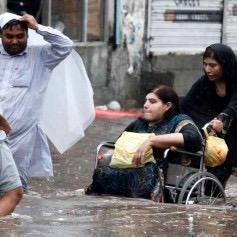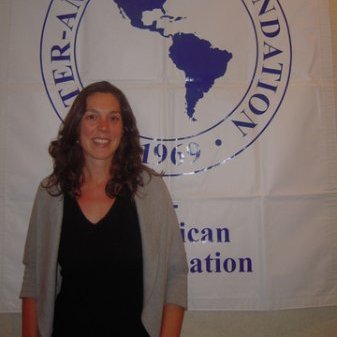 Weather-related disasters are increasing in number and severity and the number of people affected by them has risen. Disasters and their aftermath have a huge impact on persons with disabilities who sustain disproportionately higher rates of morbidity and mortality, and at the same time are among those with least access to emergency support. For example, research indicates that the mortality rate among persons with disabilities was twice that of the rest of the population during the 2011 Japan earthquake and tsunami.
Weather-related disasters are increasing in number and severity and the number of people affected by them has risen. Disasters and their aftermath have a huge impact on persons with disabilities who sustain disproportionately higher rates of morbidity and mortality, and at the same time are among those with least access to emergency support. For example, research indicates that the mortality rate among persons with disabilities was twice that of the rest of the population during the 2011 Japan earthquake and tsunami.
- Moreover, for every person that dies during a disaster, it is estimated that three people sustain an injury, many causing long-term disabilities, such as the case in Haiti after the 2010 earthquake in which approximately 200,000 people are expected to live with long-term disabilities as a result of injuries.
- Persons with disabilities are often forgotten, and most likely to be abandoned during disasters
- as well as more likely to be invisible and overlooked in emergency relief operations.
- When the emergency hits they may have difficulty reaching safe areas; become separated from family and friends, which is a key to survival and coping; have trouble accessing vital emergency information; or lose assistive devices such as wheelchairs, crutches, prostheses, white canes or hearing aids. In addition, moving and transferring persons with disabilities requires handling techniques to avoid injury or further injury. Yet, the first-ever UN global survey of persons living with disabilities and how they cope with disasters indicates that the percentage of those with disabilities who could evacuate with no difficulty almost doubles if they were given sufficient time. This underlines the importance of early warning systems and ensuring that warnings reach all members of the community regardless of any mobility or communication barriers.
- For the few persons who have been evacuated, shelters are not accessible and consequently survivors with disabilities are also excluded from the emergency responses, including: food, basic needs and health support. This is common in emergency responses, due to the underlying exclusion of persons with disabilities from Disaster Risk Reduction (DRR) processes. In addition, in the aftermath of a disaster, the damage to infrastructure caused by extreme weather events can reduce or completely remove access and safe mobility. Inclusive practice in all relief operations is needed to ensure that response and service delivery is not fragmented, but mindful of all disproportionately affected groups.
The United Nations, DRR and Persons with Disabilities
Article 11 of the United Nations Convention on the Rights of Persons with Disabilities (UN CRPD) requires that States Parties ensure the protection and safety of persons with disabilities at risk in natural disasters, armed conflict and other humanitarian crises. DRR and humanitarian situations and persons with disabilities is an increasing popular theme among Member States and UN agencies as reflected in UN meetings and events (e.g. Conference of States Parties to the CRPD, International Day of Persons with Disabilities).
In the WCDRR Post-2015 framework for disaster risk reduction zero draft outcome document there are five references to disability, one on universal design and the use of “inclusive” and “accessible” throughout the document, including accessible media.
More specifically:
- Persons with disabilities are included in the Preamble (para. 6)
- Disability perspective included into disaster-risk management
Informed decision-making based on disaggregated data, including by disability status - Investing in economic, social, cultural, and environmental resilience with the inclusion the Principles of Universal Design
- Strengthen the implementation of social safety-net mechanisms to assist the poor and at-risk groups, such persons with disabilities
- Under Role of stakeholders: “Persons with disabilities are critical in the assessment of risk and design and implementation of plans tailored to specific requirements in line with the Principles of Universal Design.”
The adoption of an inclusive post-2015 development framework on Disaster Risk Reduction at the WCDRR would be an key indication that the post-2015 development agenda must be inclusive for all and leave no one behind. Additionally, it could push for the inclusion of persons with disabilities into the DRR-related targets in the Sustainable Development Goals, currently in Target 11b (inclusive cities) and Targets 13.1, 13.3, and 13.b (climate change).
Moreover, persons with disabilities are included in the WCDRR political declaration draft in paragraph 5 of building resilient societies. Specifically, stating a commitment of Member States to accelerate their “efforts in protecting, empowering, giving attention to participation and positive contribution of, children and youth, the elderly, people with disabilities, indigenous peoples, and peoples in poverty, who could be disproportionately impacted by disasters but could also provide useful insights.”
Recommendations
(from the Committee on the Rights of Persons with Disabilities on Disability Inclusion in the Third World Conference on Disaster Risk Reduction and Beyond)
It is recommended that States Parties, the United Nations and all agencies within the United Nations system and the international community to:
- Ensure that all WCDRR processes and any relevant post-2015 sustainable development conferences be accessible to persons with disabilities, in line with the UN CRPD and other internationally recognised accessibility standards and guidelines.
- Ensure disability inclusion is included in the final outcome of the WCDRR leading to true disability-inclusive DRR, which will serve as model of best practice for a disability-inclusive human rights-based sustainable development agenda.
- Reconsider, through the United Nations General Assembly resolution, the more open and participatory structure of UN engagement in any consultation with civil society organisations by either creating an additional Major Group for persons with disabilities, or, to revisit the entire Major Group structure to become more accessible, transparent and open to full participation of all persons.
In closing, in order to truly leave no one behind, all components of DRR and the post-2015 development framework must be inclusive for all, including persons with disabilities. Let’s begin to make this happen at the WCDRR.
Author : Elizabeth Lockwood

Elizabeth Lockwood is CBM’s UN Advocacy Officer in New York. Elizabeth focuses on developing advocacy strategies to raise awareness, network, build capacity, and lobby for the rights of persons with disabilities at the UN level in relation to the UN Convention on the Rights of Persons with Disabilities and Inclusive Development. She also coordinates efforts of mainstreaming persons with disabilities in the post-2015 sustainable development agenda and conducts research and writes briefs to assist with strategies for inclusion of disability issues in Millennium Development Goal efforts. Elizabeth has worked with Deaf communities in five countries focusing on advocacy and grassroots activism, is fluent in five sign languages, and has a Ph.D. in Disability Studies.
Good article
Good article